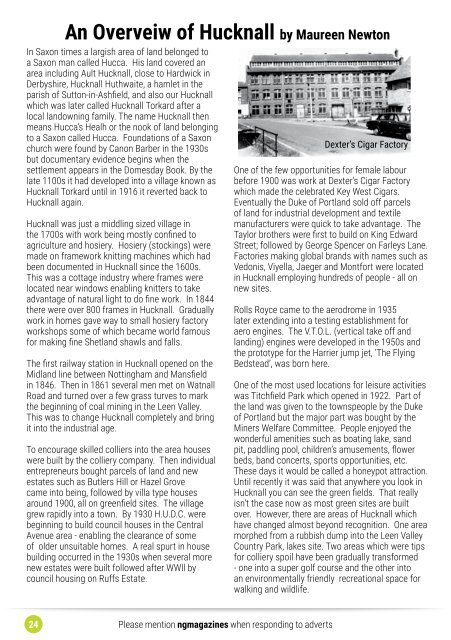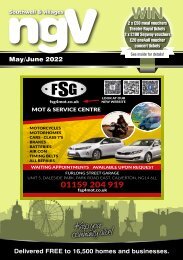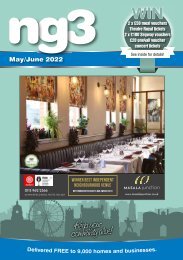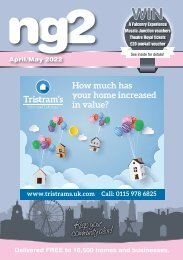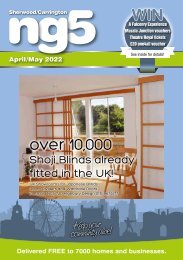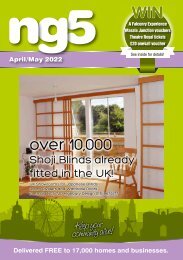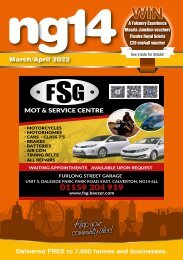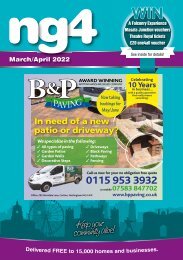NG15 July/August 2020
Local business directory and community magazine.
Local business directory and community magazine.
You also want an ePaper? Increase the reach of your titles
YUMPU automatically turns print PDFs into web optimized ePapers that Google loves.
An Overveiw of Hucknall by Maureen Newton<br />
In Saxon times a largish area of land belonged to<br />
a Saxon man called Hucca. His land covered an<br />
area including Ault Hucknall, close to Hardwick in<br />
Derbyshire, Hucknall Huthwaite, a hamlet in the<br />
parish of Sutton-in-Ashfield, and also our Hucknall<br />
which was later called Hucknall Torkard after a<br />
local landowning family. The name Hucknall then<br />
means Hucca’s Healh or the nook of land belonging<br />
to a Saxon called Hucca. Foundations of a Saxon<br />
church were found by Canon Barber in the 1930s<br />
but documentary evidence begins when the<br />
settlement appears in the Domesday Book. By the<br />
late 1100s it had developed into a village known as<br />
Hucknall Torkard until in 1916 it reverted back to<br />
Hucknall again.<br />
Hucknall was just a middling sized village in<br />
the 1700s with work being mostly confined to<br />
agriculture and hosiery. Hosiery (stockings) were<br />
made on framework knitting machines which had<br />
been documented in Hucknall since the 1600s.<br />
This was a cottage industry where frames were<br />
located near windows enabling knitters to take<br />
advantage of natural light to do fine work. In 1844<br />
there were over 800 frames in Hucknall. Gradually<br />
work in homes gave way to small hosiery factory<br />
workshops some of which became world famous<br />
for making fine Shetland shawls and falls.<br />
The first railway station in Hucknall opened on the<br />
Midland line between Nottingham and Mansfield<br />
in 1846. Then in 1861 several men met on Watnall<br />
Road and turned over a few grass turves to mark<br />
the beginning of coal mining in the Leen Valley.<br />
This was to change Hucknall completely and bring<br />
it into the industrial age.<br />
To encourage skilled colliers into the area houses<br />
were built by the colliery company. Then individual<br />
entrepreneurs bought parcels of land and new<br />
estates such as Butlers Hill or Hazel Grove<br />
came into being, followed by villa type houses<br />
around 1900, all on greenfield sites. The village<br />
grew rapidly into a town. By 1930 H.U.D.C. were<br />
beginning to build council houses in the Central<br />
Avenue area - enabling the clearance of some<br />
of older unsuitable homes. A real spurt in house<br />
building occurred in the 1930s when several more<br />
new estates were built followed after WWll by<br />
council housing on Ruffs Estate.<br />
Dexter’s Cigar Factory<br />
One of the few opportunities for female labour<br />
before 1900 was work at Dexter’s Cigar Factory<br />
which made the celebrated Key West Cigars.<br />
Eventually the Duke of Portland sold off parcels<br />
of land for industrial development and textile<br />
manufacturers were quick to take advantage. The<br />
Taylor brothers were first to build on King Edward<br />
Street; followed by George Spencer on Farleys Lane.<br />
Factories making global brands with names such as<br />
Vedonis, Viyella, Jaeger and Montfort were located<br />
in Hucknall employing hundreds of people - all on<br />
new sites.<br />
Rolls Royce came to the aerodrome in 1935<br />
later extending into a testing establishment for<br />
aero engines. The V.T.O.L. (vertical take off and<br />
landing) engines were developed in the 1950s and<br />
the prototype for the Harrier jump jet, ‘The Flying<br />
Bedstead’, was born here.<br />
One of the most used locations for leisure activities<br />
was Titchfield Park which opened in 1922. Part of<br />
the land was given to the townspeople by the Duke<br />
of Portland but the major part was bought by the<br />
Miners Welfare Committee. People enjoyed the<br />
wonderful amenities such as boating lake, sand<br />
pit, paddling pool, children’s amusements, flower<br />
beds, band concerts, sports opportunities, etc.<br />
These days it would be called a honeypot attraction.<br />
Until recently it was said that anywhere you look in<br />
Hucknall you can see the green fields. That really<br />
isn’t the case now as most green sites are built<br />
over. However, there are areas of Hucknall which<br />
have changed almost beyond recognition. One area<br />
morphed from a rubbish dump into the Leen Valley<br />
Country Park, lakes site. Two areas which were tips<br />
for colliery spoil have been gradually transformed<br />
- one into a super golf course and the other into<br />
an environmentally friendly recreational space for<br />
walking and wildlife.<br />
24 Please mention ngmagazines when responding to adverts


